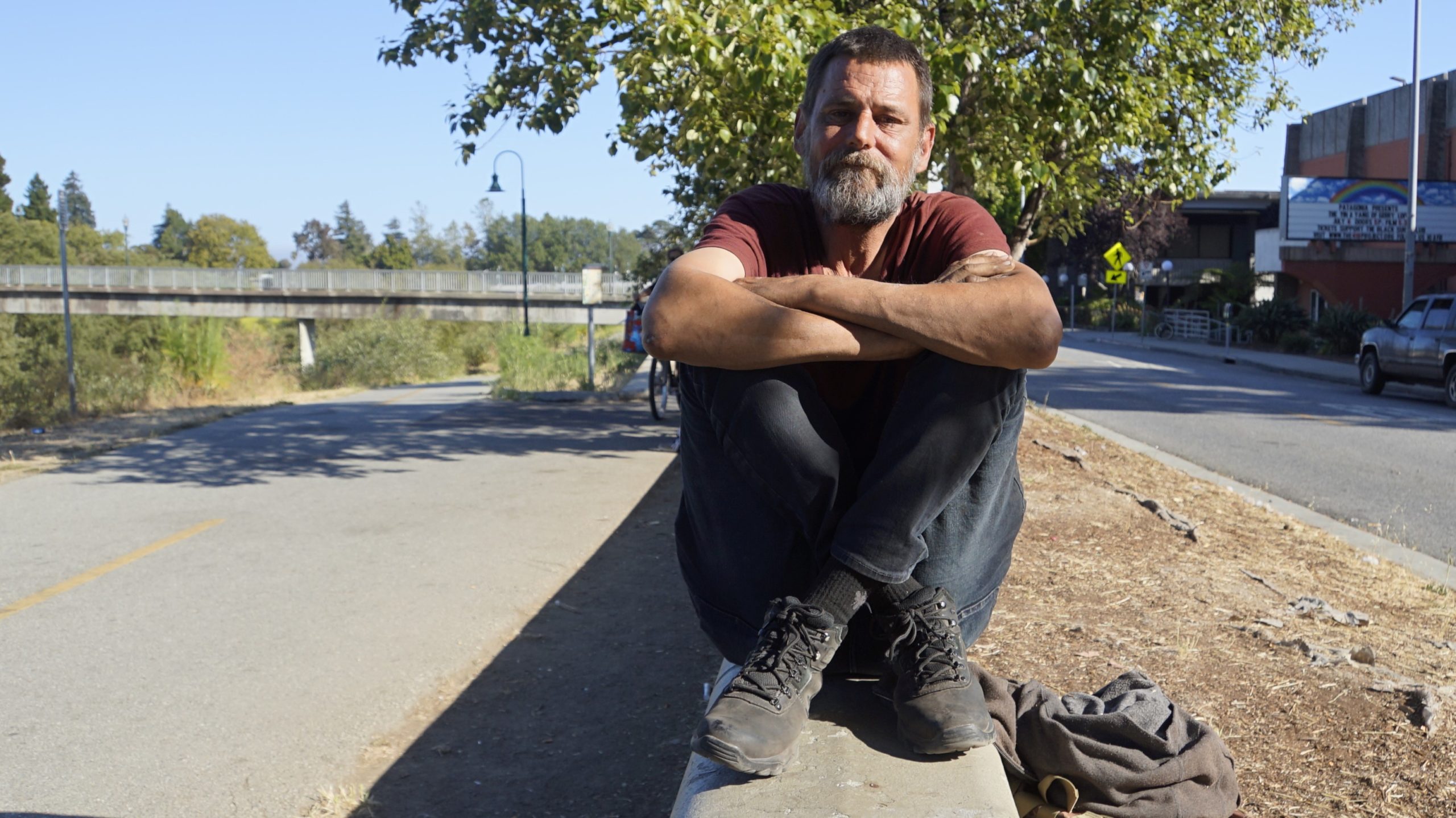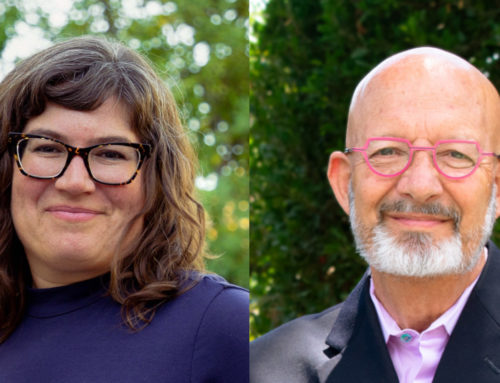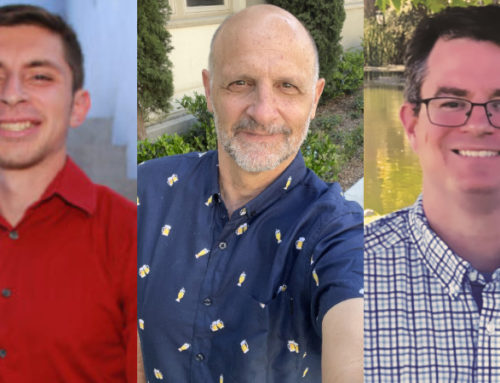
Thomas Paul says he needs permanent housing more than he needs a temporary managed camp. Paul has been part of the Downtown Streets Team and cleaned streets in Downtown Santa Cruz. (Kara Meyberg Guzman — Santa Cruz Local file)
Santa Cruz Local recently published a three-part investigation into how public money is spent on homeless services in Santa Cruz County. In today’s episode, we’ll discuss why we took on this investigation and several of the key takeaways from our reporting. We also hear from some key leaders in homeless services management.
Related stories:
- Part one: How homeless services money has been spent in Santa Cruz County
- Part two: Money sources, constraints and problems with homeless services spending in Santa Cruz County
- Part three: Is homeless services spending effective in Santa Cruz County?
- Podcast Ep. 96 “How Santa Cruz County could solve chronic homelessness
TRANSCRIPT
[INTRO MUSIC]
STEPHEN BAXTER: I’m Stephen Baxter.
KARA MEYBERG GUZMAN: And I’m Kara Meyberg Guzman.
SB: This is Santa Cruz Local. Santa Cruz Local recently published a three-part investigation. We looked at how public money has been spent on homeless services in Santa Cruz County. This spending breakdown had never been shown before in a comprehensive way.
Today we’re going to walk you through what we found and why it matters.
Kara, can you tell us why Santa Cruz Local started looking into homeless services spending in the first place?
KMG: Sure. So we really want our investigations to be tuned to the questions of Santa Cruz County residents. In fall of 2021, we interviewed about 120 residents — both housed and unhoused — and we asked, “What are your questions, concerns and priorities around homelessness? Basically, what do you want us to dig into?”
By far the top theme we heard was that people want solutions to homelessness. Another thing we heard was, please follow the money. How are my tax dollars being spent on homeless services in our county? I was surprised about how much this question — you know, how is public money spent on homeless services — how much that resonated with so many residents in our county.
We recently hosted an event at our headquarters in Downtown Santa Cruz. We talked about our investigation and what we found. The event was at capacity. There were many people who joined online. There were so many people who deeply cared about this question and wanted to know more.
SB: What were some of the big takeaways from the reporting?
KMG: Yeah, the first big takeaway is that there is no comprehensive system to track how public money is spent on homeless services in our county. There isn’t one central dashboard where you can look up all the different state, local and federal sources and how that money is being spent.
The second big takeaway is that, at the start of the COVID pandemic in 2020, spending on homeless services about tripled. But the net number of homeless people stayed about constant. So, despite a huge increase in spending in homeless services at the start of the pandemic, the net number of homeless people in our county stayed pretty much the same.
SB: Right. Or it stayed the same because of all that spending, you could argue.
KMG: Yeah, for sure. There were people getting housed, finding housing during the pandemic. But the rate of people who were returning to homelessness or becoming homeless, you know, pretty much canceled that out.
SB: We should talk a little about how homeless services are funded in Santa Cruz County.
KMG: Sure. So in Santa Cruz County, homeless services depends on state and federal dollars. In our county, we have this agency called the Housing for Health Partnership. It’s also known as the Continuum of Care. Each county in our state has a Continuum of Care. It is a federally-designated body that coordinates all the programs and services centered on preventing and ending homelessness.
Besides the Continuum of Care, the local jurisdictions like the City of Santa Cruz, the City of Watsonville, the County of Santa Cruz, those jurisdictions also receive and administer grants related to homeless services in our county.
SB: So explain to our readers exactly how we found out how much money was spent on these things?
KMG: So because there is no central database or dashboard that tracks public spending on homeless services, we had to go find that ourselves. So what that meant was a ton of Public Records Act requests. We filed requests with the City of Santa Cruz, City of Watsonville, City of Scotts Valley, Capitola, the County of Santa Cruz — and asked how much money was spent in Fiscal Years 2019-2020 and Fiscal Year 2020-2021 on homeless services? What was it spent on and when was it spent?
In return, we got thousands of pages of grant documents, board memos, budgets, agenda packets, other documents, and we combed through every single document to look for line items of spending.
So we created this giant spreadsheet that tracked how much money was spent in each fiscal year, and on what homeless services exactly. The documents were not straightforward. For example, a board memo oftentimes was not exactly clear on exactly what was spent in which year. So, this entailed many months of follow-up questions with county leaders and city leaders.
So once all of our reporting was fact checked, and we made sure it was accurate, then we created these infographics, these charts, that showed by category how much was spent on homeless services in each local jurisdiction, and in each fiscal year.
SB: Tell us more about what the charts showed.
KMG: The first thing I’ll say is that you can follow along. We’ll put a link in the show notes to the series with the charts. They’re on our website at SantaCruzLocal.org.
But so these charts, I think the first big takeaway from these charts, like I said, is that homeless services spending more than tripled from 2019 to 2021. You know of course, the backdrop of this time period is the start of the COVID pandemic. There were tens of millions of dollars more money available during the pandemic for homeless services.
From July 2019 through June 2020, at least $31.3 million was spent in our county on homeless services. The following fiscal year, it was $95.6 million, at least, spent on homeless services in our county. The largest spending category by far was temporary shelters. Nearly $52 million was spent over those two years on temporary shelter. The second largest category was rental assistance. At least $36.23 million was spent in our county on rent assistance during those two fiscal years.
SB: The charts also showed some other categories. Permanent housing development was one, the Homeless Persons Health Project was another, case management and some mental health services. But there were some caveats to the data that we found. Can you tell us more about that?
KMG: For sure. A thing to know about these charts is that it only includes public money. A lot of homeless services in our county are carried out by nonprofit groups. They have other sources of money besides local, state and federal grants. You know, for example, they get money from individual donors, other private grant programs. That money was not included in our charts.
Another thing to note is that public spending on mental health was largely not included in our charts. So the County of Santa Cruz has behavioral health programs that for sure treat many homeless people in our county. But we did not include that county behavioral health program spending in our charts. Because in their expense reports, in their budgeting, they don’t really, you know, delineate which of their clients — how much was spent on homeless clients versus housed clients. So we did not include the roughly $80 million per year that’s spent by our county on behavioral health services.
So Stephen, let’s turn it to you. I’d love to hear what are your big takeaways from our investigation.
SB: We had four big takeaways from our reporting, and the first one is easily the most important. We mentioned before, this information about how money was spent on homeless services just hasn’t been publicly available before. There hasn’t been this overarching view of how the money has been spent, and it hasn’t been as transparent as it could have been.
One person we spoke to during the reporting was Rayne Perez. Rayne was the County of Santa Cruz’s homeless services coordinator from 2016 to August 2021.
RAYNE PEREZ: The public has a right to know how the money is spent. I think that the county would be very hard-pressed to demonstrate outcomes. Because without the proper tracking systems, you can’t. If you can’t even track the expenditures in a systemic way, I think it would be hard to track outcomes in a systemic way. I think they could do it on a contract-by-contract basis. You know, this contract achieved these outcomes. But I don’t know how else they could describe it.
SB: You can’t manage what you don’t measure. So how could the public understand what’s working and what’s not if we don’t track it in this way? And this transparency, it’s achievable and it’s been planned by county leaders.
In 2021, the county leaders started this Three-Year Strategic Framework to address homelessness, and it included an online data dashboard. And they said at the time that this dashboard could track things like the number of shelter beds provided by various agencies, or how many homes have been built for low-income households, and what’s the time it takes for a person to get from a temporary shelter to a permanent home.
So it wasn’t necessarily money tracking, but it maybe could be outcome tracking in a more accountable way. So this dashboard has not come to fruition and we’re in the middle of 2023. Now, since our series on homeless services spending was published this spring, the county’s Housing for Health Partnership met on June 21st, in Capitola. And the partnership, you remember, coordinates and receives all that money from federal and state government to provide all these homeless services in our county.
During that meeting, Dr. Robert Ratner talked about what a Santa Cruz County homeless services dashboard could look like. Ratner’s the director of the county’s Housing for Health Division. He’s essentially in charge of homeless services in the county. He’s also a physician. He talked about some public dashboards that the state maintains.
The dashboard that Ratner is talking about contains some information from Santa Cruz County about the race, age, gender, and number of people who accessed homeless services. It does not contain information about money spent on homeless services, or the categories of those homeless services.
Ratner said that a dashboard in public health is supposed to be like a dashboard in a car. It’s meant to provide a small amount of information to make quick decisions. It’s a little different than what Santa Cruz Local produced and what Rayne Perez described, which is a more detailed tracking system of homeless services spending, and potentially outcomes of that spending.
ROBERT RATNER: So, I personally feel like there’s got to be some balancing of what are the things that are actually critical to share to give people a sense that positive things are happening, versus just overwhelming them with data and then continuing the narrative that this isn’t going to change.
SB: Here’s the second takeaway from our investigation into homeless services spending. There is a tension between short-term goals and long term goals.
- A short-term strategy is to open temporary shelters around the City of Santa Cruz.
- A long-term strategy is building, say, hundreds of units of permanent supportive housing around the county. Coral Street would be one area for that.
- Other longer-term strategies could involve landlord recruitment or building more housing.
A lot of time is spent on the short-term policies. They address the most visible parts of homelessness in our county. An example would be dealing with a tent camp in San Lorenzo Park. There are a lot of competing needs and limited money to try to meet those needs.
Our third takeaway: goals don’t drive homeless services, grant money does. Here’s Rayne Perez again, she’s the former homeless services coordinator for the county.
RAYNE PEREZ: What I would say is, to some extent, the fact that we chase the money that’s made available, means we do what the money is made available to do. And, in an ideal world, it would be the other way around. We would design what we want to do, and then we would apply for those funds to do specifically what we want to do. But that’s not typically how funding is made available. When you have nothing, and you have an opportunity to apply for something, you go after it. I think it’s irresponsible for a community to have a profound homelessness problem and not go out after every homeless dollar that they could bring in.
SB: The grant money is usually for specific purposes with deadlines to spend the money. Like a grant for youth services, or hotel rooms during the pandemic.
What matters is what state and federal grants can be applied for and won. The grants are usually one-time, not ongoing.
So local leaders have all these plans to address homelessness. Because homeless services are dependent on state and federal grants, those plans might not get funding.
The last takeaway: there is a maze of bureaucracy related to homeless services spending. The whole state and federal systems of grant making to try to address homelessness is pretty convoluted.
There are more than 40 sources of money. The county leaders are trying to get at all of it. It all requires applications, grant management and grant reporting. All that paperwork takes away from the direct work with unhoused people. And this is frustrating to county staff. Here’s Robert Ratner again.
ROBERT RATNER: Each funding source has different rules and different contracts and levels of staff support on the end of the funding agency that can help us understand the rules etc. There’s different start and end dates and deadlines and reporting requirements and reporting systems. So, we spent a lot of our time as staff navigating and braiding this funding together to try to get outcomes. It’s a lot of wasted taxpayer dollars, to be honest with you. The amount of time I spend, the amount of time my co-workers spend, and all of this work — we’d rather be helping people move into housing. So to the extent that the federal and state government can make it easier and consistent with the funding that we receive and be more predictable, we can have a much bigger impact on our communities.
[MUSIC]
SB: Since we published our series this spring, a lot of people have asked us, “What could the county be doing better to address homelessness?” And we found some of that in our reporting, too. Kara, could you tell us a little bit about that?
KMG: Sure. I would suggest listeners go back in your podcast feed and listen to our earlier episode called “How Santa Cruz County could solve chronic homelessness.” We looked at Bakersfield and Kern County, which achieved functional zero in chronic homelessness. And the big takeaway there, what they did was they aligned all the homeless service providers in the county towards a shared goal of actually solving chronic homelessness.
They built a really nimble operation to get people out of chronic homelessness quickly. In our county, we’re moving towards a shared goal of housing. But we’re not all the way there yet. Not all homeless service providers and local jurisdictions are on the same page.
The other thing is that Bakersfield’s operation is a lot smoother. We’ve heard from a lot of unhoused people here in our county that it’s really hard to navigate the system. It is not user friendly. It takes a long time to sign up for things like housing vouchers, getting an ID or, you know, accessing food services.
SB: Another common question we heard was, “What can I do to help the homeless situation in Santa Cruz County?”
KMG: Yeah, there’s a lot of homeless service providers in our county and a lot of them are looking for volunteers and donations. There’s groups like the Community Action Board that does a lot of work in South County. You know, there’s Housing Matters in the City of Santa Cruz. Reach out and see how you can help.
If you’re interested in providing housing, county leaders are always recruiting landlords who are willing to rent to people with housing vouchers. There’s been a shortage of landlords in recent years. So you could reach out to the Housing Authority and let them know that you’re interested.
Another powerful thing you can do is join the Housing for Health Partnership. That’s the federally-designated agency that we mentioned. It helps coordinate state and federal dollars that are spent on homeless services. You can join and, you know, work on committees that are working to prevent and end homelessness in our county. I would also recommend, reach out to your city council member, reach out to your county supervisor. Let them know that preventing and solving homelessness is important to you.
SB: Another thing I’d recommend is this book called “The Book on Ending Homelessness.” It’s by Iain De Jong. And it’s useful because it provides something like a blueprint of what has worked and what has not worked in homeless services throughout the U.S. and Canada. So it’s empowering, it’s great, you should read it.
[OUTRO MUSIC]
SB: You can read our three-part investigation on homeless services spending in Santa Cruz County at SantaCruzLocal.org. Links to those stories are in our show notes.
If you find our work useful, please donate. Our solutions to homelessness series was funded in part by $30,000 in donations in 2021. It cost a lot more than that to produce. Please donate or become a member today. You can do that at SantaCruzLocal.org. And if you’re not on our free weekly email newsletter list, to join it you can also find that at SantaCruzLocal.org.
Thank you to our highest-level members:
- Debra Szecei.
- Fran Goodwin.
- Chris Neklason.
- Elizabeth and David Doolin.
- Patrick Reilly.
I’m Stephen Baxter, thanks for listening to Santa Cruz Local.
Questions or comments? Email [email protected]. Santa Cruz Local is supported by members, major donors, sponsors and grants for the general support of our newsroom. Our news judgments are made independently and not on the basis of donor support. Learn more about Santa Cruz Local and how we are funded.
Stephen Baxter is a co-founder and editor of Santa Cruz Local. He covers Santa Cruz County government.





